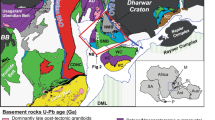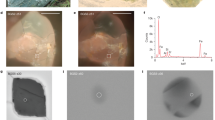Abstract
The age of the Earth's oldest crustal minerals sets a time-limit on the earliest preservation of buoyant solid crust. The oldest mineral ages reported so far are ∼4,180 Myr for detrital zircons from quartzites at Mount Narryer1, in the Yilgarn Block, Western Australia. The oldest-known intact rocks, as distinct from individual minerals, are substantially younger; they formed ∼3,813-Myr ago2 in the Isua supracrustal belt, West Greenland. We report here a further occurrence of old detrital zircons, again identified using the ion-microprobe SHRIMP3, in conglomerate from the Jack Hills Metasedimentary Belt4,5 (26°11′ S, 116°58′ E), ∼60km north-east of Narryer. This discovery is important for several reasons. First, one zircon registers the exceptionally old age of 4,276±6 Myr, which is, moreover, a minimum estimate for its original age; 16 other grains may have the same age or may be slightly younger. Second, the new occurrence considerably extends the area over which the old Narryer suite is known, thus amplifying its geological significance. Third, the frequency of old zircons in the Jack Hills occurrence is 12%, about five times higher than at Narryer, which suggests that the intact ∼4,180 Myr-old rocks, if they still exist, might be closer, and facilitates future comparison of the SHRIMP data with conventional analyses of these grains. (Recent conventional U–Pb work6 on other zircons from the same Narryer concentrate confirmed the younger ages but failed to observe any at ∼4,180 Myr, probably because of their low abundance7). The likelihood that zircon would dissolve in magmas undersaturated in zirconium8 argues against its survival in long-term contact with such magmas during the disaggregation and subduction of crust. Consequently, the existence of zircon in the Jack Hills area from ∼4,300 Myr ago implies that this part of the crust has been preserved, since then, from recirculation in the mantle through plate-tectonics or any other mechanism.
This is a preview of subscription content, access via your institution
Access options
Subscribe to this journal
Receive 51 print issues and online access
$199.00 per year
only $3.90 per issue
Buy this article
- Purchase on Springer Link
- Instant access to full article PDF
Prices may be subject to local taxes which are calculated during checkout
Similar content being viewed by others
References
Froude, D. O. et al. Nature 304, 616–618 (1983).
Baadsgaard, H. et al. Earth planet. Sci. Lett. 68, 221–228 (1984).
Compston, W., Williams, I. S. & Meyer, C. J. geophys. Res. 89, B525–534 (1984).
Elias, M. Geol. Surv. Western Australia Belele Explan. Not. (1983).
Baxter, J. L., Wilde, S. A., Pidgeon, R. T. & Fletcher, I. R. 7th Australian Geol. Conv. 56–57 (1984).
Scharer, U. & Allègre, C. Nature 315, 52–55 (1985).
Compston, W. et al. Nature 317, 559–560 (1985).
Watson, E. B. & Harrison, T. M. Earth planet. Sci. Lett. 64, 295–304 (1983).
Williams, I. R., Walker, I. M., Hocking, R. M. & Williams, S. J. Geol. Surv. Western Australia Rec. 5 (1980).
Williams, I. S., Compston, W., Black, L. P., Ireland, T. R. & Foster, J. J. Contr. Miner. Petrol. 88, 322–327 (1984).
Compston, W., Williams, I. S. & McCulloch, M. T. Aust. J. Earth Sci. (in the press).
Pidgeon, R. T. & Bowes, D. R. Geol. Mag. 109, 247–258 (1972).
Author information
Authors and Affiliations
Rights and permissions
About this article
Cite this article
Compston, W., Pidgeon, R. Jack Hills, evidence of more very old detrital zircons in Western Australia. Nature 321, 766–769 (1986). https://doi.org/10.1038/321766a0
Received:
Accepted:
Issue Date:
DOI: https://doi.org/10.1038/321766a0
This article is cited by
-
An andesitic source for Jack Hills zircon supports onset of plate tectonics in the Hadean
Nature Communications (2020)
-
Lithotectonic elements of Archean basement on the Liaodong Peninsula and its vicinity, North China Craton, China
Frontiers of Earth Science (2019)
Comments
By submitting a comment you agree to abide by our Terms and Community Guidelines. If you find something abusive or that does not comply with our terms or guidelines please flag it as inappropriate.



